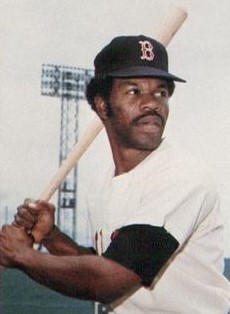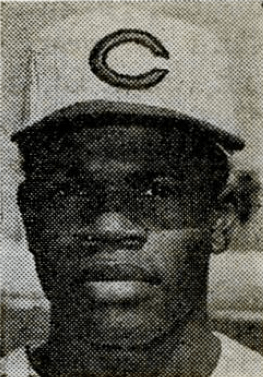Tommy Harper facts for kids
Quick facts for kids Tommy Harper |
|||
|---|---|---|---|
 |
|||
| Outfielder / Third baseman | |||
| Born: October 14, 1940 Oak Grove, Louisiana, U.S. |
|||
|
|||
| debut | |||
| April 9, 1962, for the Cincinnati Reds | |||
| Last appearance | |||
| September 29, 1976, for the Baltimore Orioles | |||
| MLB statistics | |||
| Batting average | .257 | ||
| Home runs | 146 | ||
| Runs batted in | 567 | ||
| Stolen bases | 408 | ||
| Teams | |||
As player
As coach
|
|||
| Career highlights and awards | |||
|
|||
Tommy Harper (born October 14, 1940) is a former American professional baseball player. He played as an outfielder, third baseman, and second baseman. Harper played in Major League Baseball (MLB) for seven different teams from 1962 to 1976. He spent six seasons with the Cincinnati Reds and three seasons each with the Milwaukee Brewers and the Boston Red Sox. He was chosen for one All-Star Game and was the league leader in stolen bases twice.
Contents
- Tommy Harper's Early Life and College Baseball
- Playing for the Cincinnati Reds
- Time with the Cleveland Indians
- Playing for the Seattle Pilots and Milwaukee Brewers
- Playing for the Boston Red Sox
- Time with the California Angels and Oakland Athletics
- Playing for the Baltimore Orioles
- Tommy Harper's Career Statistics
- Coaching Career and Recognition
- Career Highlights
- See also
Tommy Harper's Early Life and College Baseball
Harper played baseball at Encinal High School in Alameda, California. His teammates included Willie Stargell, who later became a Baseball Hall-of-Famer, and MLB player Curt Motton. Harper also played college baseball for San Francisco State University.
Playing for the Cincinnati Reds
Harper joined the Cincinnati Reds as a free agent before the 1960 season. He started playing for the Topeka Reds, a minor league team. In 1961, he played very well, hitting .324 with 15 home runs. This led to him being promoted to the Triple-A San Diego Padres. There, he continued to shine, hitting .333 with 26 home runs.
His great performance earned him a spot with the main Reds team in 1962. In 1965, Harper became the Reds' main left fielder and leadoff hitter. He had a fantastic season, hitting .257 with 18 home runs and 35 stolen bases. He also led the National League with 126 runs scored. He stayed in the leadoff spot for the Reds for the next three seasons.
Time with the Cleveland Indians
In November 1967, Harper was traded to the Cleveland Indians. He played only one season with the Indians. He mostly played in left and right field, but also spent time at center field and second base. After this season, Harper was chosen by the Seattle Pilots in the 1968 expansion draft.
Playing for the Seattle Pilots and Milwaukee Brewers
Harper made history as the first player to bat for the Seattle Pilots. He also got their first hit and scored their first run. He led the American League with 73 stolen bases that year. This was the most stolen bases by an American League player since 1915. This record still stands for the Pilots/Brewers team. He also showed how versatile he was by playing many different positions.
When the Pilots team moved to Milwaukee and became the Milwaukee Brewers, Harper was again the first player to bat for the team. The 1970 season was one of Harper's best. He had career highs in hits, doubles, home runs, and runs batted in (RBI). He was also chosen for his only All-Star Game. That year, he became only the fifth player in MLB history to join the 30–30 club. This means he hit 31 home runs and stole 38 bases in the same season. He finished sixth in the American League MVP voting.
Playing for the Boston Red Sox
In October 1971, Harper was traded to the Boston Red Sox. He became the Red Sox' main center fielder and leadoff hitter from 1972 to 1974. In 1973, he had his best season with the Red Sox. He led the league in stolen bases for the second time in his career, setting a Red Sox record with 54 stolen bases. This record was later broken in 2009. In 1974, he played mostly as a designated hitter.
Time with the California Angels and Oakland Athletics
Harper played part of the 1975 season for the California Angels. Later that season, he was sold to the Oakland Athletics. Joining the Athletics seemed to give him new energy. He hit very well in August and September. He became their main first baseman and also played in the outfield and at third base. He was perfect in stolen base attempts, getting 7 out of 7.
Harper helped the Athletics win their division. His ability to play many positions was very helpful. At 34 years old, after 14 seasons, Harper finally played in the playoffs. However, the Athletics were swept by his old team, the Red Sox.
Playing for the Baltimore Orioles
Harper signed with the Baltimore Orioles in April 1976. He played mostly as a designated hitter and pinch hitter. He was released by the Orioles after that season.
Tommy Harper's Career Statistics
Over 15 seasons and 1810 games, Harper had a batting average of .257. He had 1,609 hits, 972 runs, 146 home runs, and 567 RBI. He also stole 408 stolen bases. He played first base, second base, third base, and all three outfield positions during his career.
Coaching Career and Recognition
After his playing career, Harper became a coach. He coached for the Red Sox from 1980 to 1984 and again from 2000 to 2002. He also coached for the Montreal Expos from 1990 to 1999. As of 2017, he continued to work with the Red Sox as a player development consultant.
Harper had a disagreement with the Red Sox about fairness and equal treatment in the mid-1980s. He spoke up about an issue where some people were not included. He later returned to coach for the team.
In 2010, Tommy Harper was elected to the Boston Red Sox Hall of Fame.
Career Highlights
- Had a 24-game hitting streak from July 17 to August 8, 1966.
- Had 16 games where he got four hits.
- Stole four bases in one game against the Chicago White Sox on June 18, 1969.
- Had three games where he stole three bases.
- Was an All-Star in 1970.
- Led the National League in runs with 126 in 1965.
- Led the American League in stolen bases twice (73 in 1969; 54 in 1973).
- Became the fifth player to join the 30–30 club (31 home runs and 38 stolen bases in 1970).
- Was named the Boston Red Sox MVP in 1973.
- Finished in the top 10 for the American League MVP in 1970.
- His 408 career stolen bases rank him 69th on the all-time list.
- Holds single-season stolen base records for the Brewers.
See also
- 30–30 club
- List of Major League Baseball annual runs scored leaders
- List of Major League Baseball annual stolen base leaders
- List of Major League Baseball career stolen bases leaders


